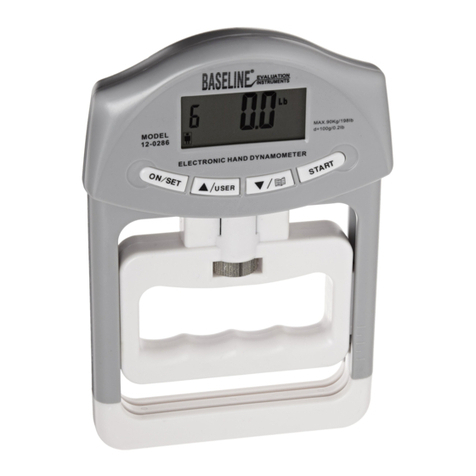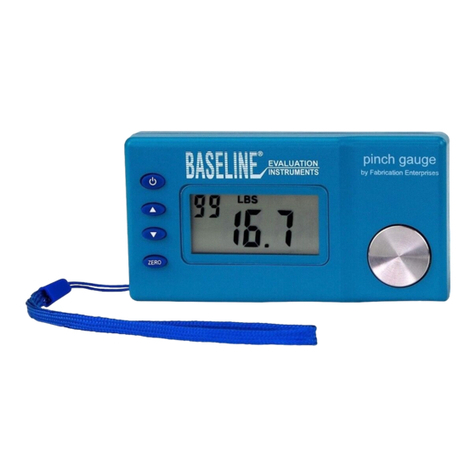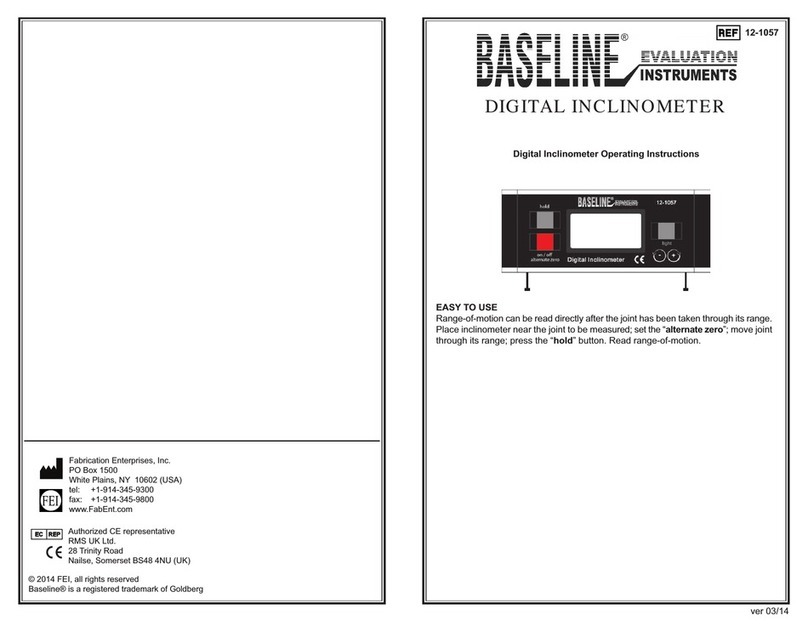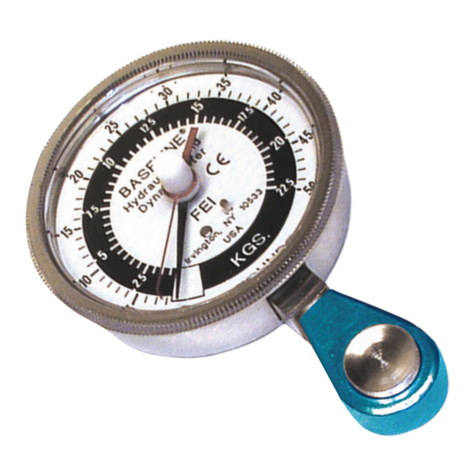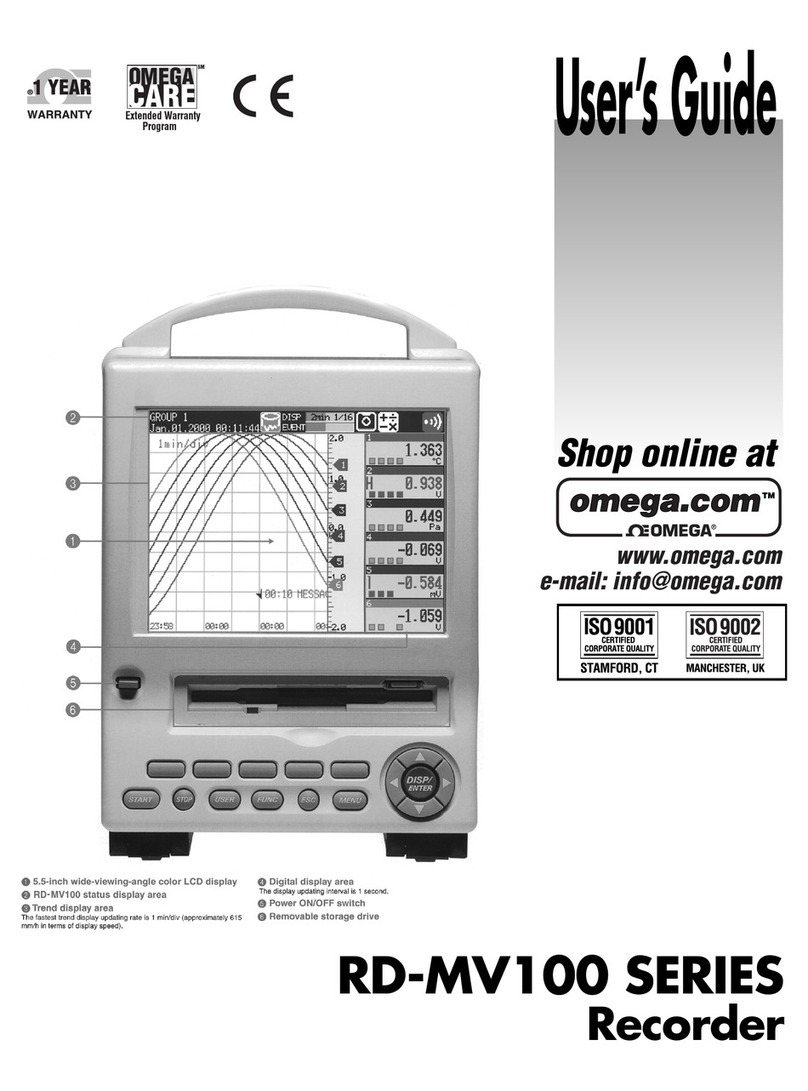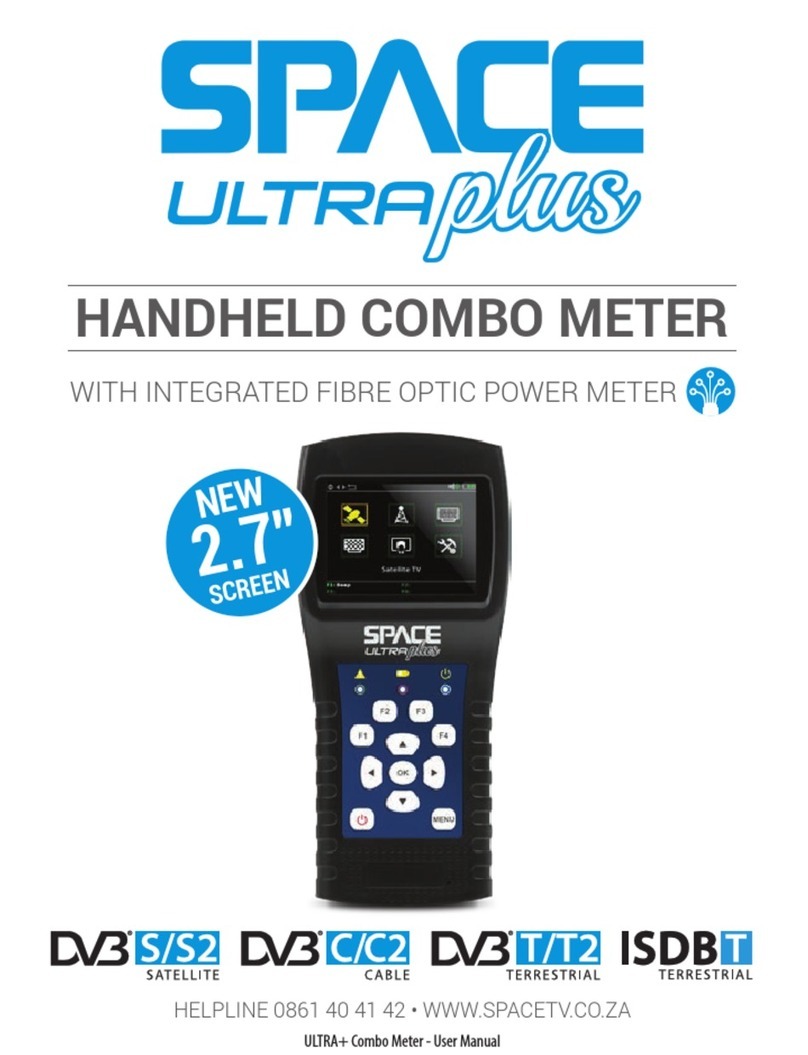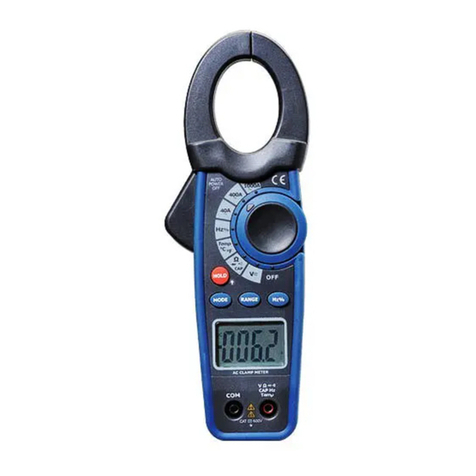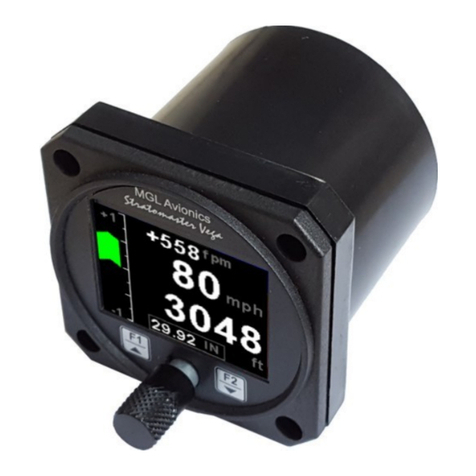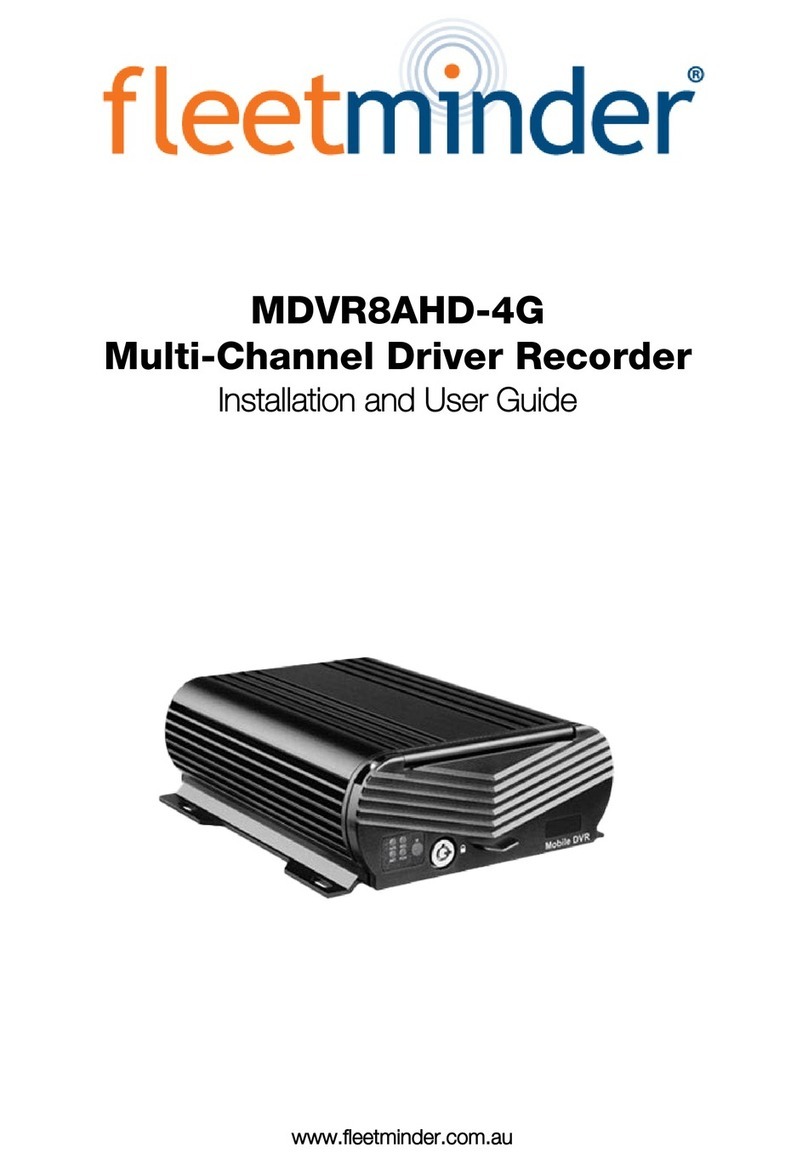Base Line 12-0340 User manual

Push / Pull Dynamometers
12-0340
12-0341
12-0342
12-0343
User’s Guide

Baseline® Push / Pull Dynamometers User’s Guide
1
Thank you…
Thank you for purchasing a Baseline dynamometer, designed for push and pull force testing applications
up to:
With proper usage, we are confident that you will get many years of great service with this product.
Baseline dynamometers are ruggedly built for many years of service in laboratory and industrial
environments.
This User’s Guide provides setup, safety, and operation instructions. Dimensions and specifications are
also provided. For additional information or answers to your questions, please do not hesitate to contact
us. Our technical support and engineering teams are eager to assist you.
Before use, each person who is to use a Baseline dynamometer should be fully trained in
appropriate operation and safety procedures.
TABLE OF CONTENTS
SAFETY..............................................................2
POWER...............................................................3
MECHANICAL SETUP.......................................4
HOME SCREEN AND CONTROLS ...................5
OPERATING MODES.........................................6
CHANGING THE UNITS.....................................6
DIGITAL FILTERS..............................................7
CALIBRATION ...................................................7
OTHER SETTINGS.......................................... 12
SPECIFICATIONS........................................... 14
Model
lbF
kgF
N
12-0340
50 x 0.05
25 x 0.02
250 x 0.2
12-0341
100 x 0.1
50 x 0.05
500 x 0.5
12-0342
250 x 0.2
100 x 0.1
1000 x 1
12-0343
500 x 0.5
250 x 0.2
2500 x 2

Baseline® Push / Pull Dynamometers User’s Guide
2
1 SAFETY
Caution!
Note the dynamometer’s capacity before use and ensure that the capacity is not exceeded.
Producing a force greater than 200% of the dynamometer’s capacity can damage the internal load
cell. An overload can occur whether the dynamometer is powered on or off.
The following safety checks and procedures should be performed before and during operation:
1. Never operate the dynamometer if there is any visible damage to the AC adapter or the
dynamometer itself.
2. Ensure that the dynamometer is kept away from water or any other electrically conductive liquids
at all times.
3. The dynamometer should be serviced by a trained technician only. AC power must be
disconnected and the dynamometer must be powered off before the housing is opened.
4. Always consider the characteristics of the sample being tested before initiating a test. A risk
assessment should be carried out beforehand to ensure that all safety measures have been
addressed and implemented.
5. Wear eye and face protection when testing, especially when testing brittle samples that have the
potential to shatter under force. Be aware of the dangers posed by potential energy that can
accumulate in the sample during testing. Extra bodily protection should be worn if a destructive
failure of a test sample is possible.
6. In certain applications, such as the testing of brittle samples that can shatter, or other applications
that could lead to a hazardous situation, it is strongly recommended that a machine guarding
system be employed to protect the operator and others in the vicinity from shards or debris.
7. When the dynamometer is not in use, ensure that the power is turned off.

Baseline® Push / Pull Dynamometers User’s Guide
3
2 POWER
Caution!
Do not use AC adapters other than supplied or instrument damage may occur.
The dynamometer is powered either by an 8.4V rechargeable battery or by an AC adapter (input jack is
located in the left side of the housing).
If the AC adapter is plugged in, an icon appears in the lower left corner of the display, as follows:
If the AC adapter is not plugged in, battery power drainage is denoted in a five-step process:
1. When battery life is greater than 75%, the following indicator is present:
2. When battery life is between 50% and 75%, the following indicator is present:
3. When battery life is between 25% and 50%, the following indicator is present:
4. When battery life is less than 25%, the following indicator is present:
5. When battery life drops to approximately 2%, the indicator from step 4 will be flashing.
Several minutes after (timing depends on usage and whether the backlight is turned on or
off), a message appears, “BATTERY VOLTAGE TOO LOW. POWERING OFF”. An audio
tone will sound and the dynamometer will power off.
The dynamometer can be configured to automatically power off following a period of inactivity. Refer to
the Other Settings section for details.
Battery life is approximately 24 hours with the backlight off, or 7 hours with the backlight on. To change
the battery, loosen the two captive screws on the back side of the housing and separate the two housing
halves. A foam strip separates the battery from the PCB, as shown in the illustration below:
Ensure that the foam is positioned above the battery when reassembling the housing. Exercise care when
reassembling the two halves of the housing, ensuring that internal wires do not interfere.

Baseline® Push / Pull Dynamometers User’s Guide
4
3 MECHANICAL SETUP
3.1 Loading shaft orientation
In order to accommodate a variety of testing requirements, the orientation of the loading shaft may be
oriented in either of the two positions shown below. To change the loading shaft orientation, loosen the
two captive screws on the back side of the housing, separate the two housing halves, rotate one half 180
degrees, and reassemble. Exercise care when reassembling the two halves of the housing, ensuring that
internal wires do not interfere.
Load cell shaft up Load cell shaft down
3.2 Mounting to a plate
Although the dynamometer may be used by hand, proper mounting is important if attached to a fixture or
test stand. The round steel insert with a hole in the back of the housing is provided to withstand the load
during a test. A mating dowel pin should be used (see illustration below). An additional two holes are
supplied for metric screws. These holes are designed to accommodate screws in order to hold the
dynamometer in place. The screws must not be used for load bearing purposes. Failure to use a dowel
pin properly can result in a hazardous situation.
3.3 Mounting attachments to the dynamometer
The dynamometer’s threaded loading shaft is designed to accommodate attachments with female
threads. To mount n attachment, gently thread it onto the shaft. Attachments may not orient in a parallel
manner when tight. In such cases, do not over-tighten, or damage will occur. Loosen the attachment to
the desired position, and use in this manner, or use a jam nut to prevent the attachment from rotating.
Use two wrenches to tighten a jam nut; the second wrench should engage the flat section of the load cell
shaft. This is to prevent loosening of the loading shaft, which can lead to damage.

Baseline® Push / Pull Dynamometers User’s Guide
5
4 HOME SCREEN AND CONTROLS
4.1 Home Screen
No.
Name
Description
1
Primary reading
The current displayed force reading. See Operating Modes section for
details.
2
Units
The current unit of measurement. Abbreviations are as follows:
lbF –Pound-force
kgF –Kilogram-force
N –Newton
3
Mode
The current measurement mode. Abbreviations are as follows:
RT –Real Time
PC –Peak Compression (push)
PT –Peak Tension (pull)
See Operating Modes section for details about each of these modes
4
Battery / AC
adapter indicator
Either the AC adapter icon or battery power icon will be shown, depending on
power conditions. Refer to the Power section for details.
5
Pull / push
indicator
- indicates a push direction
- indicates a pull direction
4.2 Controls
Primary
Label
Primary Function
Secondary
Label
Secondary Function
Powers the dynamometer on and
off. Press briefly to power on, press
and hold to power off. Active only
when the home screen is displayed.
ENTER
Various uses, as described in the
following sections.
ZERO
Zeroes the primary reading.
(UP)
Navigates up through the menu and
sub-menus.
MENU
Enters the main menu.
ESCAPE
Reverts one step backwards through
the menu hierarchy.
PEAK
Toggles between real-time and peak
measurement modes.
(DOWN)
Navigates down through the menu
and sub-menus.
Note: Units are configured through the menu. Refer to the Changing The Units section for details.
1
2
3
4
5

Baseline® Push / Pull Dynamometers User’s Guide
6
4.3 Menu navigation basics
Most of the dynamometer’s various functions and parameters are configured through the main menu. To
access the menu press MENU. Use the UP and DOWN keys to scroll through the items. The current
selection is denoted with clear text over a dark background. Press ENTER to select a menu item, then
use UP and DOWN again to scroll through the sub-menus. Press ENTER again to select the sub-menu
item.
For parameters that may be either selected or deselected, press ENTER to toggle between selecting and
deselecting. An asterisk (*) to the left of the parameter label is used to indicate when the parameter has
been selected.
For parameters requiring the input of a numerical value, use the UP and DOWN keys to increment or
decrement the value. Press and hold either key to auto-increment at a gradually increasing rate. When
the desired value has been reached, press ENTER to save the change and revert back to the sub-menu
item, or press ESCAPE to revert back to the sub-menu item without saving. Press ESCAPE to revert one
step back in the menu hierarchy until back into normal operating mode.
Refer to the following sections for details about setting up particular functions and parameters.
5 OPERATING MODES
Caution!
In any operating mode, if the capacity of the instrument has been exceeded by more than 110%,
the display will show “OVER” to indicate an overload.
Three operating modes are possible. To cycle between the modes, press PEAK while in the home
screen.
5.1 Real time (RT)
The primary reading corresponds to the live measured reading.
5.2 Peak Compression (PC)
The primary reading corresponds to the peak push reading observed. If the actual force decreases from
the peak value, the peak will still be retained in the primary reading area of the display. Pressing ZERO
will reset the value.
5.3 Peak Tension (PT)
Same as Peak Compression, but for pull forces.
6 CHANGING THE UNITS
To change the measuring unit, select Units from the menu. The display appears as follows:
The dynamometer will always power on with the unit selected.
UNITS
* lbF
kgF
N

Baseline® Push / Pull Dynamometers User’s Guide
7
7DIGITAL FILTERS
Digital filters are provided to help smooth out the readings in situations where there is mechanical
interference in the work area or test sample. These filters utilize the moving average technique in which
consecutive readings are pushed through a buffer and the displayed reading is the average of the buffer
contents. By varying the length of the buffer, a variable smoothing effect can be achieved. The selection
of 1 will disable the filter since the average of a single value is the value itself.
To access digital filter settings, select Filters from the menu. The display appears as follows:
Two filters are available:
Current Reading –Applies to the peak capture rate of the instrument.
Displayed Reading –Applies to the primary reading on the display.
Available settings: 1,2,4,8,16,32,64,128,256,512,1024. It is recommended to keep the current reading
filter at its lowest value for best performance, and the displayed reading filter at its highest value for best
visual stability.
8CALIBRATION
8.1 Initial Physical Setup
The dynamometer should be mounted vertically to a test stand or fixture rugged enough to withstand a
load equal to the full capacity of the instrument. Certified deadweights or master load cells should be
used, along with appropriate mounting brackets and fixtures. Caution should be taken while handling
such equipment.
8.2 Calibration Procedure
1. Select Calibration from the menu. The display appears as follows:
2. Press DIRECTION to invert the display, if desired. ENTER to continue. The display appears as
follows:
CALIBRATION
To invert the
display, press the
DIRECTION button,
then press ENTER
DIGITAL FILTERS
(1 = Fastest)
Current Reading
8
Displayed Reading
128

Baseline® Push / Pull Dynamometers User’s Guide
8
The dynamometer can be calibrated at up to 10 points in each direction. Enter the number of
calibration points for each direction (compression and tension). At least one point must be
selected for each direction.
Note: To achieve the accuracy specification of ±0.5%, it is recommended to calibrate the
dynamometer at 5 or more even increments in both tension and compression directions. For
example, a dynamometer with capacity of 100 lbF should be calibrated at 20, 40, 60, 80, and 100
lb loads in each direction.
3. To escape the Calibration menu at any time, press ESCAPE. The display appears as follows:
Selecting “Cancel” will revert back to the Calibration setup. Selecting “Exit without saving” will
return to the menu without saving changes.
4. After the number of calibration points has been entered, press ENTER. The display appears as
follows:
5. Place the dynamometer horizontally on a level surface free from vibration, then press ZERO. The
dynamometer will calculate internal offsets, and the display appears as follows:
CALIBRATION
NOT COMPLETE
Cancel
Exit without saving
CALIBRATION
Enter # cal points
(1 to 10)
Compression:
5
Tension:
5
CALIBRATION
OFFSET
Please wait…
CALIBRATION
OFFSET
Place dynamometer
horizontally, then
press ZERO

Baseline® Push / Pull Dynamometers User’s Guide
9
If failed:
6. The following screen appears after the offsets have been calculated:
Attach weight fixtures (brackets, hooks, etc), as required. Do not yet attach any weights or apply
any calibration loads. Press ENTER.
7. The display appears as follows:
Optionally exercise the load cell shaft several times (at full scale, if possible), then press ENTER.
8. The display appears as follows:
Apply a weight equal to the full scale of the instrument, then press ENTER.
9. After displaying “Please wait…” the display appears as follows:
Remove the load applied in Step 8, leave the fixtures in place, then press ZERO.
CALIBRATION
COMPRESSION
Gain adjust
Apply full scale load
100.000 lbF +/-20%,
Then press ENTER
CALIBRATION
COMPRESSION
Ensure no load
Then press ZERO
CALIBRATION
COMPRESSION
Attach necessary
weight fixtures,
then press ENTER
CALIBRATION
COMPRESSION
Optionally exercise
sensor, then press
ENTER
CALIBRATION
OFFSET
Sensor Failed
Analog Failed
CALIBRATION
OFFSET
Sensor Passed
Analog Passed

Baseline® Push / Pull Dynamometers User’s Guide
10
10. The display appears as follows:
Use the UP and DOWN keys to adjust the load value as required. The load values default to even
increments, as indicated by the previously entered number of data points (even increments are
recommended for best results). For example, if a 100 lbF capacity dynamometer is calibrated,
and 5 data points were selected, the load values will default to 20, 40, 60, 80, and 100 lb. Apply
the calibration load. Then press ENTER.
Repeat the above step for the number of data points selected.
11. After all the compression calibration points have been completed, the display appears as follows:
Press ENTER.
12. The display appears as follows:
Reverse the orientation of the load cell shaft by rotating the dynamometer 180 degrees. Press
DIRECTION to invert the display. Then attach weight fixtures. The following screens will step
through the same procedure as with the compression direction. Proceed in the same manner.
13. At the completion of the tension calibration, the display appears as follows:
To save the calibration information, select “Save & exit”. To exit without saving the data select
“Exit without saving”.
CALIBRATION
To invert the
display, press the
DIRECTION button,
then press ENTER
CALIBRATION
COMPLETE
Save & exit
Exit without saving
CALIBRATION
COMPRESSION COMPLETE
Reverse direction
for Tension
Attach necessary
weight fixtures,
then press ENTER
CALIBRATION
COMPRESSION
Apply load
1 OF 5
Enter load:
20.000 lbF
Press ENTER

Baseline® Push / Pull Dynamometers User’s Guide
11
14. Any errors are reported by the following screens:
Displayed at the start of calibration if a disallowed unit is selected.
Ensure that the load is not swinging, oscillating, or vibrating in any manner. Then try again.
The calibration weight does not match the set value.
The entered calibration point is too close to the previous point.
CALIBRATION
TENSION
Load too close
to previous
Please try again
CALIBRATION
Load not stable
Please try again
CALIBRATION
Units must be kgF
Please try again
Press ENTER
CALIBRATION
COMPRESSION
Load too low
Please try again

Baseline® Push / Pull Dynamometers User’s Guide
12
9OTHER SETTINGS
9.1 Automatic Shutoff
The dynamometer may be configured to automatically power off following a period of inactivity while on
battery power. Inactivity is defined as the absence of any key presses or load changes of 100 counts or
less. To access these settings, select Automatic Shutoff from the menu. The display appears as follows:
Selection
Description
Disabled
Disable automatic shutoff.
Enabled
Enable automatic shutoff.
Set Minutes
The length of time of inactivity. Available settings: 5-30, in 5 minute increments.
Note: If the AC adapter is plugged in, the dynamometer will ignore these settings and remain powered on
until the POWER key is pressed.
9.2 Backlight
Several initial settings are available, upon powering on the dynamometer. To access these settings,
select Backlight from the menu. The display appears as follows:
Select Off for the backlight to be off upon powering on the dynamometer.
Select On for the backlight to be on upon powering on the dynamometer.
Select Auto for the backlight to be on upon powering dynamometer, but will shut off after a period of
inactivity (as defined in the Automatic Shutoff sub-section). The backlight will turn on again when activity
resumes. The length of time of inactivity is programmed in minutes via the Set Minutes parameter.
Available settings: 1-10, in 1 minute increments.
Note: If the AC adapter is plugged in, the dynamometer will ignore these settings and keep the backlight
on. Selecting the On or Off setting in the Backlight menu will manually turn the backlight on or off as if
the Backlight key were pressed.
9.3 LCD Contrast
The contrast of the display may be adjusted. Select LCD Contrast from the menu. The screen appears
as follows:
BACKLIGHT
Off
On
* Auto
Set Minutes
1
AUTOMATIC SHUTOFF
* Disabled
Enabled
Set Minutes
5

Baseline® Push / Pull Dynamometers User’s Guide
13
Press ENTER to modify the contrast. Select a value from 0 to 25, 25 producing the most contrast.
9.4 Initial Mode
This section is used to configure the initial mode upon powering on the dynamometer. To access this
parameter, select Initial Mode from the menu. The screen appears as follows:
The default value is Real Time.
9.5 Restore Default Settings
Default factory settings can be restored by selecting Restore Defaults from the menu. The settings may
be found in the Specifications section. The screen appears as follows:
9.6 Information / Welcome Screen
The following screen is displayed at power-up and can be accessed at any time by selecting Information
from the menu:
RESTORE DEFAULT
SETTINGS?
No
Yes
Push / Pull Dynamometer
Model No: 12-0342
Serial No: 1234567
Version: 2.0
INITIAL MODE
* Real Time
Peak Compression
Peak Tension
LCD CONTRAST
Set Contrast
10

Baseline® Push / Pull Dynamometers User’s Guide
14
10 SPECIFICATIONS
10.1 General
Accuracy:
±0.5% of full scale
Sampling rate:
500 Hz
Power:
AC or rechargeable battery, with multi-step low battery indicator
Battery life:
Backlight on: up to 7 hours of continuous use
Backlight off: up to 24 hours of continuous use
Safe overload:
200% of full scale (display shows “OVER” at 110% and above)
Weight:
12-0340 –12-0341: 0.7 lb [0.33 kg]
12-0342 –12-0343: 0.9 lb [0.41 kg]
Environmental
requirements:
40 - 100°F, max. 93% humidity, non-condensating
Warranty:
3 years (see individual statement for further details)
10.2 Factory Default Settings
Parameter
Setting
Filters
Current
8
Displayed
128
Backlight
Auto
Minutes
1
Automatic Shutoff
Enabled
Minutes
5
LCD Contrast
10
Initial Mode
Real Time
Units
lbF
10.3 Capacity, Resolution & Load Cell Deflection
Model
lbF
kgF
N
12-0340
50 x 0.05
25 x 0.02
250 x 0.2
12-0341
100 x 0.1
50 x 0.05
500 x 0.5
12-0342
250 x 0.2
100 x 0.1
1000 x 1
12-0343
500 x 0.5
250 x 0.2
2500 x 2

Baseline® Push / Pull Dynamometers User’s Guide
15
10.4 Dimensions
IN [MM]

Baseline® Push / Pull Dynamometers User’s Guide
16
NOTES:

Baseline® Push / Pull Dynamometers User’s Guide
17
The Baseline® electronic push-pull dynamometer uses state-of-the-art “load-cell” technology to assure the
highest standards of accuracy, repeatability and reliability. The unit is available in four measurement ranges
and comes complete with 3 push pads, 1 pull hook, 1 snap hook and a padded carrying case. Optional single
and dual grip handles available.
CE certified. Handles and accessories are interchangeable with the Baseline® Hydraulic Push-Pull
Dynamometer. Can be used with lift platform to conduct muscle strength and functional capacity tests.
Model
lbF
kgF
N
12-0340
50 x 0.05
25 x 0.02
250 x 0.2
12-0341
100 x 0.1
50 x 0.05
500 x 0.5
12-0342
250 x 0.2
100 x 0.1
1000 x 1
12-0343
500 x 0.5
250 x 0.2
2500 x 2
Optional accessories (sold separately):
Dual grip Handle (12-0389)
Single grip Handle (12-0385)
Baseline®is a trademark of Goldberg.
Rev 0620
Fabrication Enterprises Inc.
250 Clearbrook Road, Suite 240
Elmsford, NY 10523 (USA)
tel: +1-914-345-9300 • 800-431-2830
fax: +1-914-345-9800 • 800-634-5370
FabEnt.com
EC REP
Authorized CE representative:
AJW Technology Consulting GmbH
Königsallee 106
40215 Düsseldorf (Germany)
This manual suits for next models
3
Table of contents
Other Base Line Measuring Instrument manuals
Popular Measuring Instrument manuals by other brands

FTS
FTS Bubbler user manual

Endress+Hauser
Endress+Hauser Proline Prowirl 73 Brief operating instructions
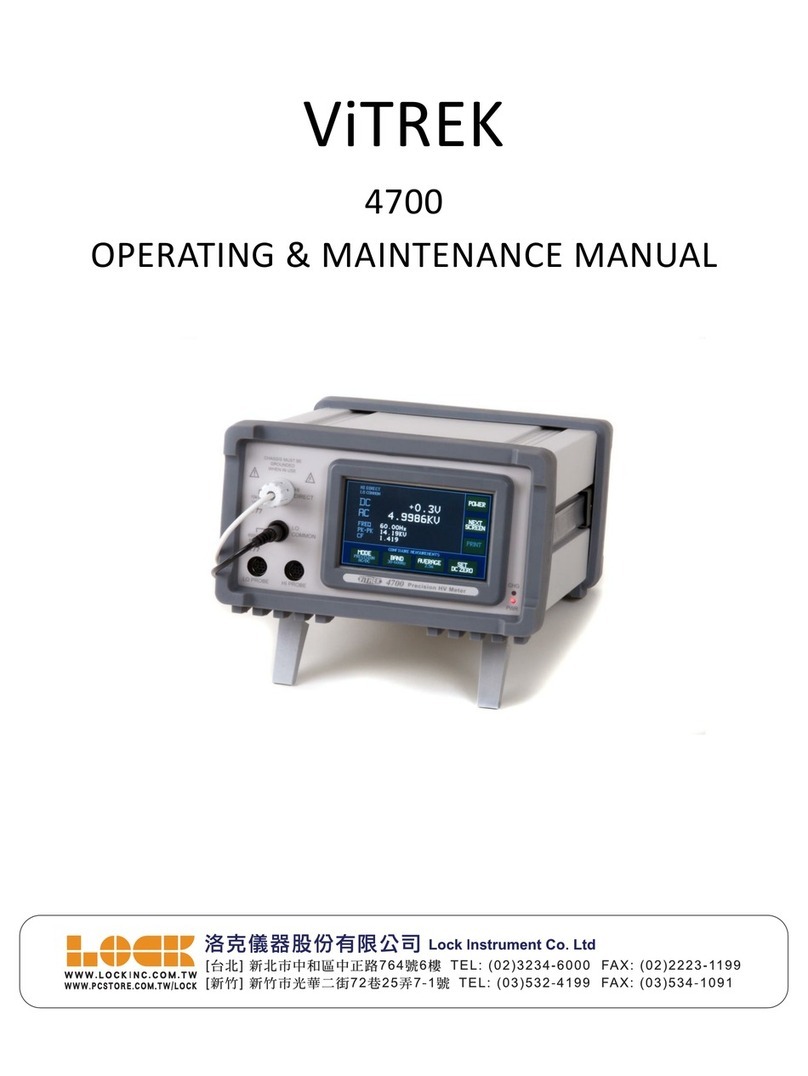
Vitrek
Vitrek 4700 Operating and maintenance manual

Simrad
Simrad PI PURSE SEINE HYDROPHONE - INSTALLATION REV... installation manual
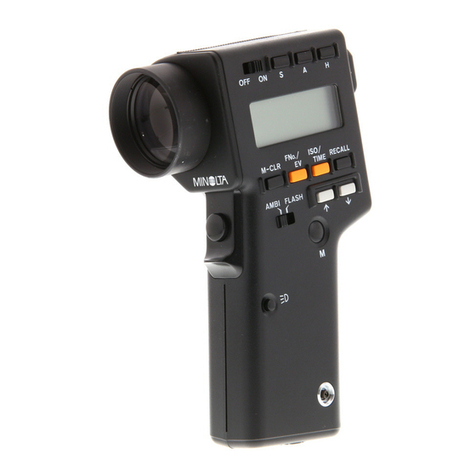
Minolta
Minolta SPOTMETER F - IR REMOTE CONTRO LRC-3 manual

Matoha
Matoha PlasTell Quick reference guide

Apera Instruments
Apera Instruments 950 Series user manual
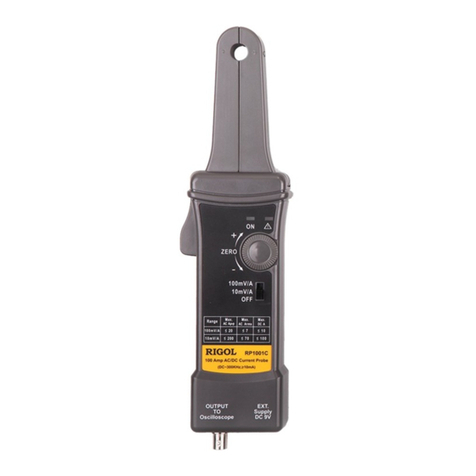
Rigol
Rigol RP1001C user guide
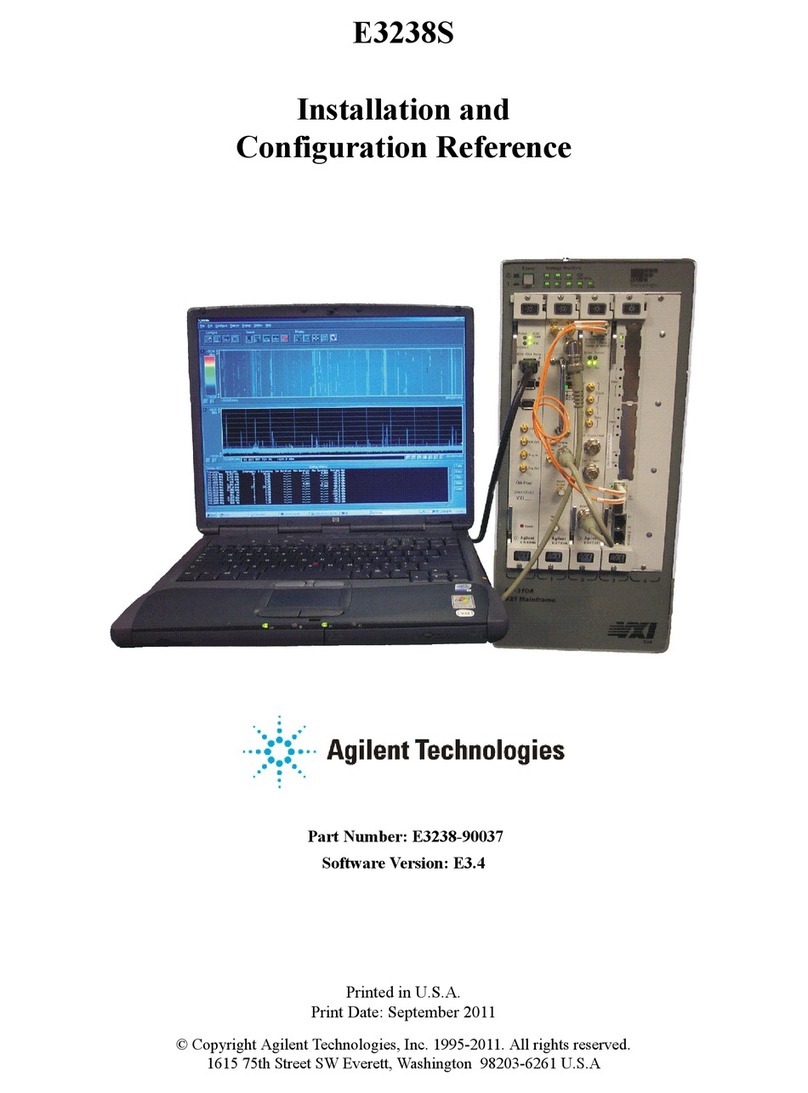
Agilent Technologies
Agilent Technologies E3238S Installation and Configuration Reference

Iwatsu
Iwatsu SS-281A instruction manual

Velleman
Velleman DVM8030 user manual
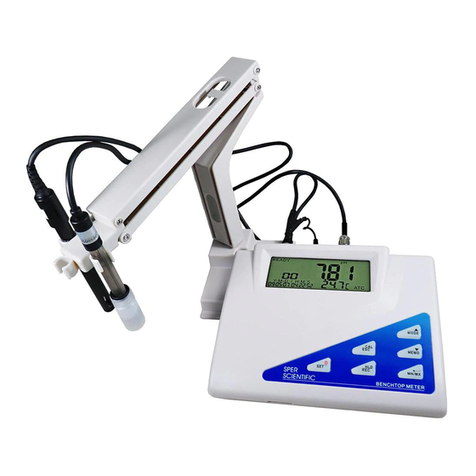
Sper scientific
Sper scientific 860032 instruction manual

